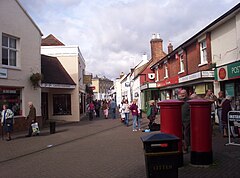Hythe and Dibden
| Hythe | |
|---|---|
 High Street, Hythe |
|
| Hythe shown within Hampshire | |
| Population | 19,930 20,526 (2011 Census) |
| OS grid reference | SU421076 |
| Civil parish |
|
| District | |
| Shire county | |
| Region | |
| Country | England |
| Sovereign state | United Kingdom |
| Post town | SOUTHAMPTON |
| Postcode district | SO45 |
| Dialling code | 023 |
| Police | Hampshire |
| Fire | Hampshire |
| Ambulance | South Central |
| EU Parliament | South East England |
| UK Parliament | |
| Website | Hythe and Dibden Parish Council |
Hythe (/haɪð/) is a town near Southampton, Hampshire, England. It is located by the shore of Southampton Water, and has a ferry service connecting it to Southampton. Hythe has a small shopping area, a pier, and a marina for yachts.
The name Hythe means landing-place or haven. Hythe is recorded in a Parliamentary roll from 1293. The Hythe ferry ("Hitheferye") to Southampton is marked on a map by Christopher Saxton of 1575, and on a map by John Harrison in 1788. Hythe was part of the parish of Fawley, although it became a separate ecclesiastical parish in 1841. The current church, of Saint John the Baptist, was erected in 1874. It is of red brick with Bath Stone dressings. There were at one time stocks in the village.
The Hampshire Advertiser, 23 Dec 1837, reports the death of John Richards of Hythe (1764-1837) and notes 'the father of the deceased founded the neat little village of Hythe: previous to his time there was no building there of greater pretensions than the huts of a few fishermen. The elder Mr Richards, when he established a shipbuilding yard at Heath (as it was then called) built houses for his workmen and the village soon sprang up.'
At the beginning of the 20th century, Hythe was a "little fishing village"; with an hourly steamboat service to Southampton, and with the clubhouse of Hythe Yacht Club at the end of the pier. Hythe remained part of the civil parish of Fawley until 1913, when it became part of the parish of Dibden.
Thanks in part to the BPBC and its excellent access to the English Channel, during World War II Hythe was used as a port for the "little ships" of the Royal Navy, the Motor Torpedo Boats and the RAF Air/Sea Rescue Boats. In 1960, The Hovercraft Development Company and Sir Christopher Cockerell, its founder, moved to Hythe. There was also a small airforce base in Hythe known as RAF Hythe. Until its closure in September 2006 it was used by the United States Army to service and maintain watercraft. Part of the site is now used by the local Air Training Corps squadron.
...
Wikipedia

